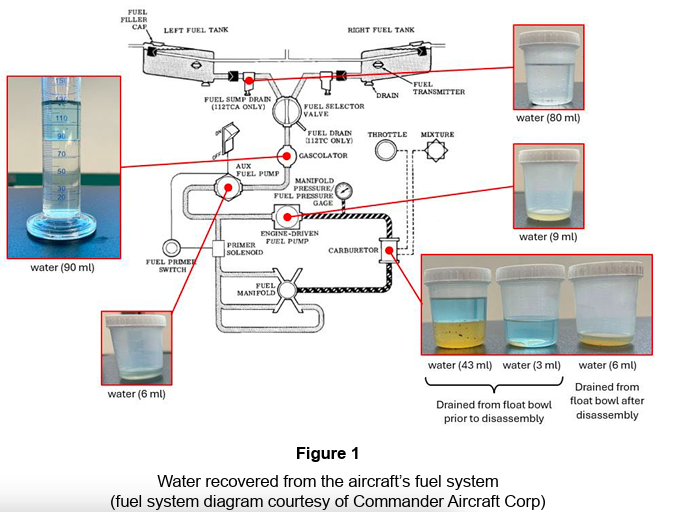Lessons Learned: Rockwell Commander Destroyed, Fatality

A Rockwell Commander 112 TCA, N4698W, at Kinglassie, Fife, was destroyed and a pilot death incurred after a normal takeoff.
Following a normal takeoff roll, on the initial climb-out the Rockwell Commander aircraft’s engine lost power due to water ingestion in the carburetor. The aircraft was observed to depart from controlled flight and it struck an area of rising ground, fatally injuring the pilot. Investigation of the aircraft’s fuel system revealed significant water contamination that had not been removed during the pre-flight inspection.
The Rockwell Commander aircraft was based at Fife Airport, near Glenrothes, and was owned by the pilot. On the day of the accident, CCTV footage showed the pilot arriving at the airport at 1100 hrs and walking to N4698W aircraft, parked at the southwestern end of the apron.
The view of the Rockwell Commander 112 TCA, N4698W, on the CCTV was obscured by parked aircraft, so it was not possible to clearly observe the pre-flight actions of the pilot. A witness reported that the aircraft’s engine was running while parked on the apron for approximately 20 minutes before CCTV recorded it taxiing at 1128 hrs.
On seeing the N4698W taxiing, a witness in another aircraft called on the radio to check the pilot’s intentions. The pilot told him that he intended to depart the circuit for a brief local f light before returning. N4698W was then seen entering the runway, backtracking to the threshold of Runway 24, and stopping. The witness recalled the engine running at high power for about 20 seconds before the takeoff run, which began at 1133:18 hrs. CCTV recorded N4698W climbing out to the southwest until 1134:20 hrs, when it appeared to depart abruptly from controlled flight, possibly entering an incipient spin.
At approximately the same time, CCTV in the village of Kinglassie, one mile southwest, recorded the sound of an engine misfiring, followed by images of N4698W striking rising ground nearby. The witness at the airport reported hearing a brief MAYDAY call from the pilot. Airport responders arrived quickly at the scene and found local residents already present. They secured the aircraft by turning off the ignition and fuel. Police arrived on scene at 1155 hrs. The pilot was fatally injured in the impact.
Content and Image credit: “AAIB [Air Accidents Investigation Branch] Special Bulletin S1 2025: Rockwell Commander 112 TCA N4698W‘.
Read more about the AAIB investigation at the above link.



